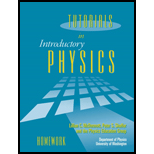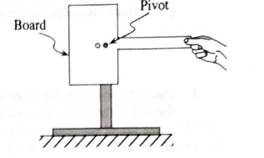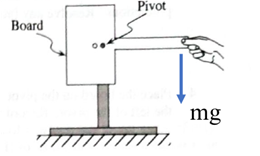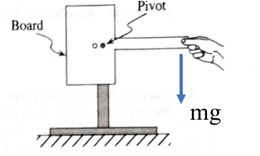
A T-shaped board of uniform mass density has two small holes as shown. Initially, the pivot is placedthrough the right hole, which corresponds to the center of mass of the board. The board ¡s then held in place.
1. Predict the motion of the board after it is released from rest, Explain.

2. Check your prediction by observing the demonstration.
a. Describe the
What does your answer imply about the ne, torque about the pivot? Explain.
b. Describe the acceleration of the center of mass of the board. Explain how you can tell.
What does your answer imply about the net force acting on the board? Explain.
3. Explain how your answers about net torque and net force in question 2 would change, if at all, if there is appreciable friction between the board and the pivot and the board remains at rest.
(1)
To Predict: The motion of the board.
Answer to Problem 1aT
The board will perform a circular repetitive motion.
Explanation of Solution
Given:
Gravitational force is acting downward on the edge of the handle.

Formula used:
Calculation:
Conclusion:
The gravitational force at the edge of the handle leads to produce torque using equation in formula. r is the distance between the edge of the handle and the pivot around which the board will rotate. Angle between r and force is 90 degree.
(2)
To Describe: The angular acceleration of the board, acceleration of the center of mass and the net torque about the pivot.
Explanation of Solution
Given:

Formula used:
Where, I is the moment of inertia and
Calculation:
From part 1, the net torque is
From the rotational equation of motion:
On comparing both the equations:
The center of mass of the board lies on the axis of rotation, therefore, the acceleration of the center of mass is zero.
The net torque is
Conclusion:
Hence, the angular acceleration is
(3)
The effect of friction on the torque and force.
Answer to Problem 1aT
The net torque and force will be reduced due to friction in effect.
Explanation of Solution
Given:
Gravitational force is acting downward on the edge of the handle.
Formula used:
Calculation:
Conclusion:
The frictional force acts opposite to the motion of the object. Hence, net force and torque are reduced which eventually reduces the angular acceleration and linear acceleration.
Want to see more full solutions like this?
Chapter 4 Solutions
Tutorials In Introductory Physics: Homework
Additional Science Textbook Solutions
Human Physiology: An Integrated Approach (8th Edition)
Physics for Scientists and Engineers: A Strategic Approach, Vol. 1 (Chs 1-21) (4th Edition)
Genetic Analysis: An Integrated Approach (3rd Edition)
Campbell Biology: Concepts & Connections (9th Edition)
Biology: Life on Earth (11th Edition)
Organic Chemistry (8th Edition)
- 8. With the aid of a diagram draw the following electric circuit and use the resistor as the load, (a) Closed circuit (b) Open circuitarrow_forwardLab 8 Part 3 PHET Wave Interface simulation. I am having trouble with this part of the lab.arrow_forwardMick and Rick are twins born on Earth in the year 2175. Rick grows up to be an Earth-bound robotics technician while Mick becomes an intergalactic astronaut. Mick leaves the Earth on his first space mission in the year 2200 and travels, according to his clock, for 10 years at a speed of 0.75c. Unfortunately, at this point in his journey, the structure of his ship undergoes mechanical breakdown and the ship explodes. How old is Rick when his brother dies?arrow_forward
 University Physics Volume 1PhysicsISBN:9781938168277Author:William Moebs, Samuel J. Ling, Jeff SannyPublisher:OpenStax - Rice University
University Physics Volume 1PhysicsISBN:9781938168277Author:William Moebs, Samuel J. Ling, Jeff SannyPublisher:OpenStax - Rice University Principles of Physics: A Calculus-Based TextPhysicsISBN:9781133104261Author:Raymond A. Serway, John W. JewettPublisher:Cengage Learning
Principles of Physics: A Calculus-Based TextPhysicsISBN:9781133104261Author:Raymond A. Serway, John W. JewettPublisher:Cengage Learning Glencoe Physics: Principles and Problems, Student...PhysicsISBN:9780078807213Author:Paul W. ZitzewitzPublisher:Glencoe/McGraw-Hill
Glencoe Physics: Principles and Problems, Student...PhysicsISBN:9780078807213Author:Paul W. ZitzewitzPublisher:Glencoe/McGraw-Hill Physics for Scientists and Engineers: Foundations...PhysicsISBN:9781133939146Author:Katz, Debora M.Publisher:Cengage Learning
Physics for Scientists and Engineers: Foundations...PhysicsISBN:9781133939146Author:Katz, Debora M.Publisher:Cengage Learning Physics for Scientists and Engineers, Technology ...PhysicsISBN:9781305116399Author:Raymond A. Serway, John W. JewettPublisher:Cengage Learning
Physics for Scientists and Engineers, Technology ...PhysicsISBN:9781305116399Author:Raymond A. Serway, John W. JewettPublisher:Cengage Learning College PhysicsPhysicsISBN:9781938168000Author:Paul Peter Urone, Roger HinrichsPublisher:OpenStax College
College PhysicsPhysicsISBN:9781938168000Author:Paul Peter Urone, Roger HinrichsPublisher:OpenStax College





